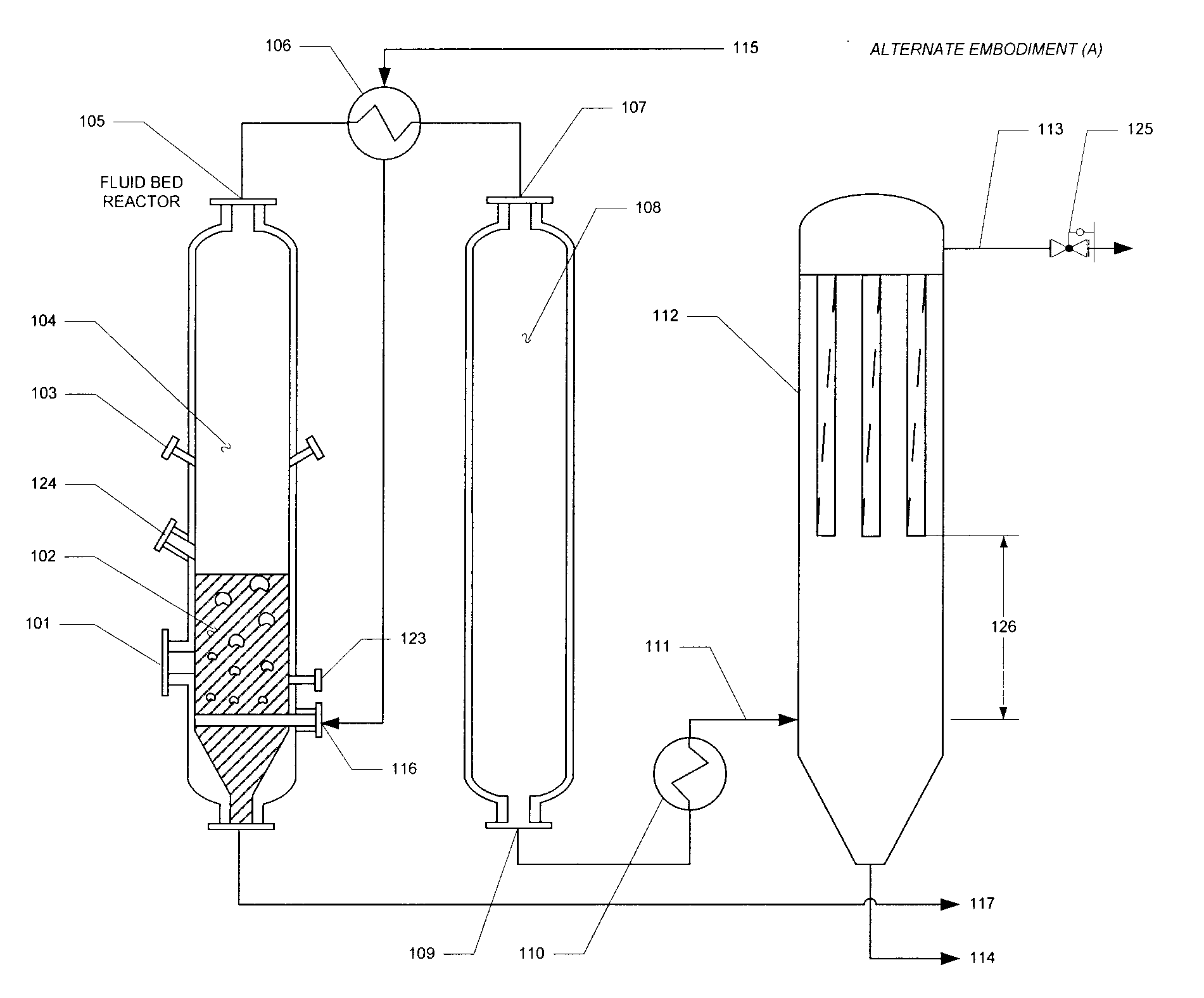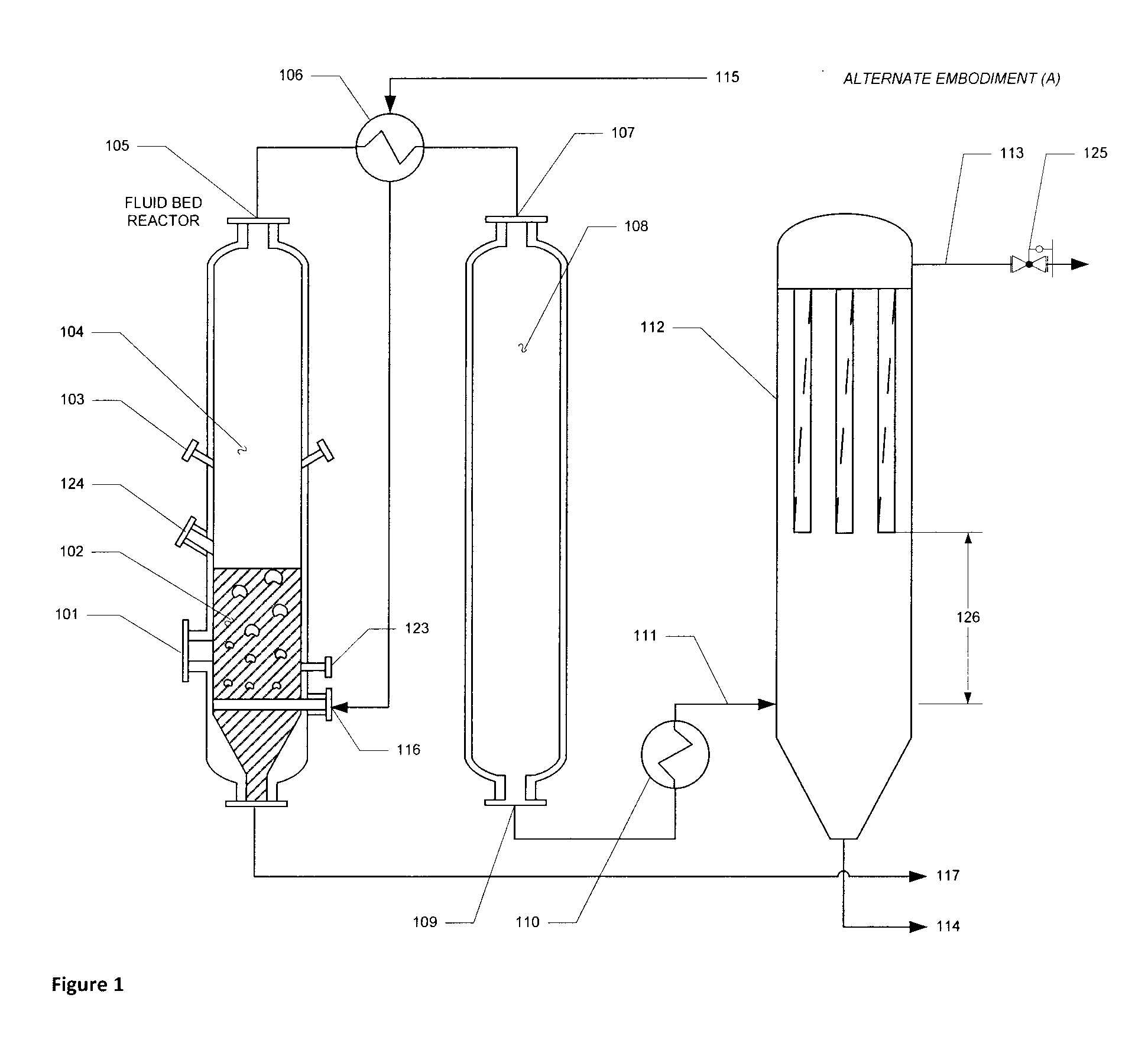Apparatus and method of optimized acid gas and toxic metal control in gasifier produced gases
a technology of acid gas and toxic metals, which is applied in the direction of combustible gas production, combustible gas purification/modification, and separation processes, etc. it can solve the problems of large contact volume, inability to effectively utilize sorbent, and inability to achieve the effect of reducing the number of sorbents, reducing the efficiency of sorbent utilization, and less than ideal sorbent performan
- Summary
- Abstract
- Description
- Claims
- Application Information
AI Technical Summary
Benefits of technology
Problems solved by technology
Method used
Image
Examples
example 1
[0042]Table 1 provides the pertinent data providing a baseline against which the other examples will be compared. The baseline assumes that a singular sorbent effect is employed. In practice, multiple effects are at play. A bubbling fluid bed gasifier is operated at 1500° F. by feeding an appropriate ratio of air and fuel. Biomass is fed at the rate of 6500 lbs / hr and contains 251.4 ppm chlorine (dry basis). Granular limestone is co-fed at the rate of 1% of the biomass feed, or about 14.5 moles Ca / mol HCl. Gas is generated at the rate of 15,470 lbs / hr wet (2.38 lbs wet gas / lb biomass as fed). The initial HCl concentration is 100.0 ppmv in the freeboard, assuming 100% chlorine release as hydrogen chloride, and assuming there is no uptake of chloride by the biochar ash—even though it is known that biochar ash elements previously described have effective sorbent properties. The desired superficial velocity is 4 ft / second (a target for producing the desired lime and bio-char particle si...
example-2
[0043]This next example demonstrates the benefit of the gas-sorption residence time chamber or zone. The diameter of the gas-sorbent contact vessel (108) is modified from 2 ft to 8 ft, and the length retained at 30 ft.
[0044]The optimized temperature set point result is presented in Table 2. Trend study for this example is presented in FIG. 7. The optimized case achieves 3.3 ppm HCl (˜96.7% removal) with 825° F. in the filter vessel (112) and 900° F. in the intermediate gas-sorbent contact vessel (108). The final concentration is about 33% higher if the temperatures are equivalent in (108) and (112).
TABLE 2(Example 2) 100 ppmv HCl initial; 3.31 ppm HCl final, 20% moisture gas, 2.068 atm (15 psig); 15,470 pph gas.DwellKINETIC RESULTSLengthVolumeVelocityTime[HCl]EQ[HCl]% Cum.ZoneT (° F.)D (ft)(ft)(ft3)† (ft / s)(s)(ppmv)‡(ppmv)Capture1041500° 6.0020.0565.54.005.001944.0100.00.0%108900°8.0030.01508.01.7017.662.95913.986.1%112825°10.520.01392.50.93217.260.6023.3196.7%† Superficial velocity...
example-3
[0045]This third example demonstrates the benefit of added volume in the filter vessel by increasing its height by 17-ft beyond 20 ft (the height typically be used in an apparatus set up as described). This filter height extension could be done as a convenient way to increase sorbent contact residence time in the practice of this invention with or without including the intermediate sorbent contact vessel. The dimensions of the gas-sorbent contact vessel (108) of Example-2 are retained in this third case, i.e., diameter modified to 8 feet, length the same at 30 feet.
TABLE 3(Example 3) 100 ppmv HCl initial, 1.00 ppm HCl final, 20% moisture gas, 2.068 atm (15 psig); 15,470 pph gas.DwellKINETIC RESULTSLengthVolumeVelocityTime[HCl]EQ[HCl]% Cum.ZoneT (° F.)D (ft)(ft)(ft3)† (ft / s)(s)(ppmv)‡(ppmv)Capture1041500° 6.0020.0565.54.005.001944.0100.00.0%108900°8.0030.01508.01.7017.662.95913.986.1%112825°10.537.02864.50.91436.200.3331.0099.0%† Superficial velocity.*Excludes volume of bags / filter e...
PUM
| Property | Measurement | Unit |
|---|---|---|
| velocity | aaaaa | aaaaa |
| constant velocity | aaaaa | aaaaa |
| contact residence time | aaaaa | aaaaa |
Abstract
Description
Claims
Application Information
 Login to View More
Login to View More - R&D
- Intellectual Property
- Life Sciences
- Materials
- Tech Scout
- Unparalleled Data Quality
- Higher Quality Content
- 60% Fewer Hallucinations
Browse by: Latest US Patents, China's latest patents, Technical Efficacy Thesaurus, Application Domain, Technology Topic, Popular Technical Reports.
© 2025 PatSnap. All rights reserved.Legal|Privacy policy|Modern Slavery Act Transparency Statement|Sitemap|About US| Contact US: help@patsnap.com



